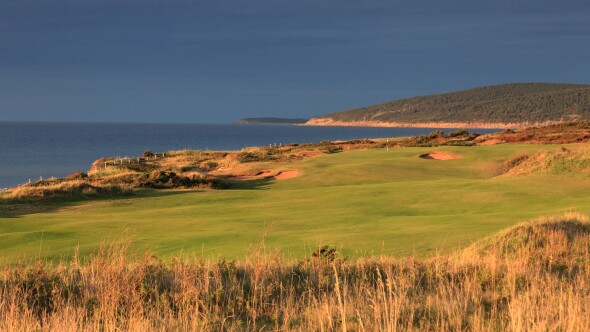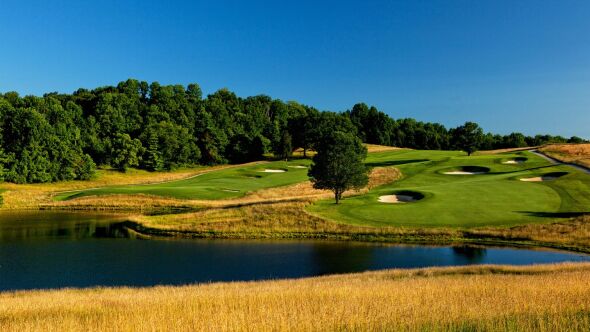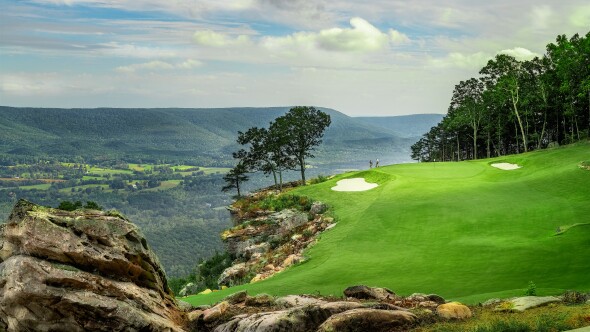PINEHURST, N.C. — The mark of a great golf property is that the folks who run it are never content to sit back on their laurels. They always want to improve.
Case in point: Pinehurst Resort in the Sandhills of central North Carolina. With three recent U.S. Opens that ran seamlessly well – 1999 (won by Payne Stewart), 2005 (Michael Campbell) and 2014 (Martin Kaymer, and then Michele Wie in the following U.S. Women’s Open) and another U.S. Open slated for 2024, there would be good reason to be content with its standing among the elite of American golf resorts.
But the folks who run this 123-year old property for (and with) the owner, Robert H. Dedman Jr., have been steadily at work upgrading what is now a 10-course retreat. The latest addition to their already impressive repertoire include a complete overhaul of the Donald Ross-designed No. 4 Course plus the creation of The Cradle, a stunning little par-3 layout and a new sports bar/ale house called The Brewery on the grounds of the old, long-abandoned steam plant in town. Life has never been better for Pinehurst. And there’s likely more to come.
The resort’s management raised a few eyebrows eight years ago when it decided to take the legendary Pinehurst No. 2 and let the design team of Bill Coore and Ben Crenshaw return it to a look of scruffy old sandy wasteland and lots of broken ground in place of 40-acres of Bermudagrass rough that had transformed the place from ground-game golf to an aerial layout. When No. 2 reopened in 2012 the course provided industry-wide evidence that the retro look – with two-thirds of its irrigation turned off, wire grass returned along the side and a commitment not to overseed – made sense environmentally and from the standpoint of easier maintenance. It was also more engaging to play. The conversion of the greens two years ago from bentgrass to Champions Bermudagrass was the next step in that evolution, providing a tract that was more consistent in presentation throughout the calendar.
Now comes the latest big change – a complete redo of the No. 4 Course. In the process, architect Gil Hanse literally undid all the work of modernization that Tom Fazio had showcased for the place back in 2000 when he had redone the layout. Gone are the elevated greens and aerial approaches, the perched fairways, heavily manicured roughs and the proliferation of deep sand hazards (229 bunkers in all, 26 of them on the par-5 ninth hole alone). The golf course now sits back on grade. It looks like it fits the land rather than riding atop it.

“This was not a restoration,” says Hanse. For someone whose many restoration credits include such Ross gems as Aronimink Golf Club in Pa., Plainfield Country Club in Edison, N.J., and Sakonnet Golf Club in Little Compton, R.I., the terminology is important. Full disclosure: I worked with Hanse preparing historical background documentation on his restoration plans for Oakland Hills Country Club in Birmingham, Mi., Worcester (Ma.) Country Club and Whitinsvile (Ma.) Golf Club.
Podcast: Gil Hanse and Matt Ginella discuss Pinehurst from the Dornoch Cottage
Pinehurst No. 4 did not lend itself to textbook restoration because the course had evolved dramatically since the incarnation of Ross’ routing in 1919. The documentation provided by architect/historian Richard Mandell in his book Pinehurst: Home of American Golf (2007) shows at least four major reroutings of No. 4, three of them after Ross’ death in 1948. When Coore and Crenshaw restored No. 2, they wisely chose 1936 as the target year – when the modern routing of that course was achieved in time for that year’s PGA Championship. There was no such “steady-state” arrival of No. 4 as a settled routing. That gave Hanse a lot of latitude. He studied earlier bunker plans, but the bulk of his work, he says, “was restoring the basic landforms and flow of the topography.” He also put the greens back to grade level.
Hanse is known for doing his own shaping work. That means spending his days operating a bulldozer or excavator, invariably with his iPod ear buds blaring while he creates the forms he thinks is appropriate. The work is undertaken with his in-house crew, a firm called Caveman Construction. Hanse’s partner in all of this planning, budgeting and sculpting the last 23 years is Jim Wagner. Their design/build operation is part of a growing movement in modern golf architecture that achieves unique shapes by teasing them out of the dirt rather than designing it all on paper and handing it off to a generic contractor.
During six months of the most intensive work on No. 4 Hanse and his wife, Tracey, lived in Ross' house, called Dornoch Cottage, overlooking the third green of the No. 2 Course. “It was pretty humbling to wake up there and walk around knowing that Mr. Ross had spent the last two decades of his life living there and doing all the work he became famous for.” says Hanse. “It made us feel even more responsible for coming up with something interesting and that was also true to Ross’ overall design approach.”

Ross designed on the ground, scraping his features out and occasionally building up only the platform called “the fill pad” that contains the putting surface and bunkers at its base. In restoring the original landforms, Hanse brought most of the bunkers back to earth, occasionally blending in a putting surface into the high side of an existing grade and letting the outslope provide a natural feed away from the target line.
That’s what makes the rerouted par-3 4th hole so intimidating. The earlier hole, a Fazio incarnation, sat lakeside in a low area that was filled. Hanse slid the green 30 degrees to the left onto a natural run that drips down from the left and virtually collapses once outside the putting surface down a slope to the right. At 153 yards from the back, 83 yards from the front, and 140-119 yards from the intermediate markers, it’s not a difficult shot – unless you yank it slightly or let it drift off. It’s immediately reminiscent of two other short par 3s on classic courses on which Hanse has worked – the sixth at Royal Dornoch in Scotland and the seventh at Palmetto Club, Aiken, S.C. As with those holes, the new fourth at No. 4 puts a very bad swing thought into your head: hit the little green or miss it and end up playing Ping-Pong for recovery.
With 45 acres of fairway No. 4 is generous off the tee. And with run up as an option on just about every hole it’s very forgiving if you’re easily satisfied with hitting a green – anywhere on the green. A great example comes at the dogleg left par-4 third hole – 431 yards down to 276. The surface sits about six feet lower than its predecessor and is welcoming. But a massive slope intrudes from the right, cutting off the ground hook line and leaving low slung approaches short and left of center for any hole cut deeper than mid way or far right.
With its elements sitting in the land rather than perched above it, the new No. 4 is easily walkable. A rerouting on holes 11-12 has really helped connect the dots, with the new par-3/4 sequence replacing a previous par-4/3 alignment on awkward, sharply sloped ground. The saltshaker bunkering on that overly busy old ninth hole has been dissolved into the native sand scrape as a Hell’s Half Acre.

There’s a good spread of yardages out where for this par-72 layout: from 7,227 to 5,428. A minor qualm is the big gap between what should be the most attractive options: 6,428 (white) and 5,864 (green). There are a few areas where placement of slightly longer teeing grounds could prove helpful in getting that green tee up to a more golfer-receptive yardage of, say 6,002 yards. I’m thinking especially of the short par-4 15th, 331 (white) and 245 (green) where a platform at ideal grade and angle is waiting to be built at 300 yards.
The best part of the new No. 4 is being able to watch the ball run out on the greens. That’s not always been a feature of Hanse courses. In the past he’s been occasionally so enamored with the blind approach that golfers are deprived of the pleasure watching their approach shots take the ground contours. And with those greens back on terra firma the old problem of forced aerial approaches onto unreceptive convexes has been solved.
Back in 2000 I played the then-reopened No. 4 course on opening day with longtime Pinehurst Director of Grounds Bob Farren. Last week we reprised our round together on the dedication of the new No. 4. For old times sake I wore the same hat from last time - a vintage 1999 U.S. Open Pinehurst/Toro crew hat.
That round was work. This one was fun.






















As a former family member of PCC, we felt Fazio ruined #4
in 1999, with all the elevated greens and more than 200 traps.
We liked #7 the best after #2.
Hope Hanse can make it great again.
While nice of Brad to provide full disclosure (below), he should have passed on this assignment.
Also, 2 ll's in Whitinsville. :)
"For someone whose many restoration credits include such Ross gems as Aronimink Golf Club in Pa., Plainfield Country Club in Edison, N.J., and Sakonnet Golf Club in Little Compton, R.I., the terminology is important. Full disclosure: I worked with Hanse preparing historical background documentation on his restoration plans for Oakland Hills Country Club in Birmingham, Mi., Worcester (Ma.) Country Club and Whitinsvile (Ma.) Golf Club."
Simply wonderful news, and while certainly not a “restoration” in the classic sense, I cannot help but believe that Mr Ross would be far happier with this than the Fabio experiment.